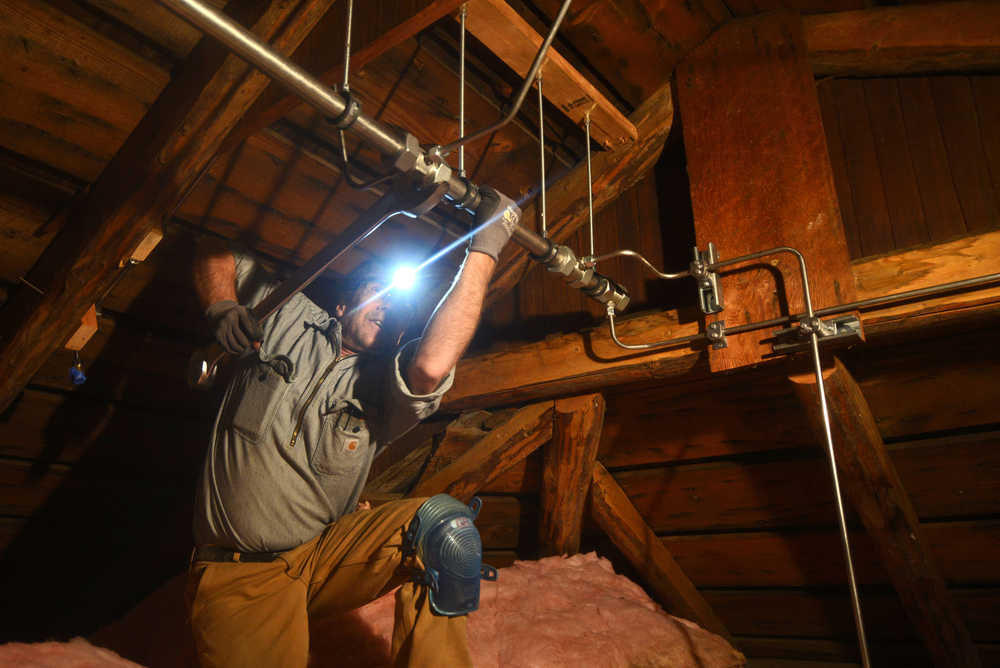KENAI — A system designed to extinguish fires without damaging the Holy Assumption of the Virgin Mary Russian Orthodox Church’s collection of icons, art and archived documents is being installed in the historic church building in Old Town Kenai.
The church and nonprofit preservation group Russian Orthodox Sacred Sites in Alaska (ROSSIA) fundraised $61,623 for the restoration in early 2016, according to ROSSIA’s website on the effort.
Electrician Richard Cutting of Anchorage’s Megawatt Electric normally bends and installs pipe to pass electrical wires through.
He’s working now with contractor ATS Alaska on installing the 38-millimeter-diameter main pipes and 12 millimeter-diameter distribution pipes that will carry water and pressurized gas through the church in the event of a fire.
The building that houses Holy Assumption’s gift shop also houses a water drum and a rack of 24 tanks filled with nitrogen gas at 3,000 pounds of pressure.
When the Hi-Fog system is triggered, the gas will force water through an underground pipe into the church, where the 3,000 pounds of pressure will be strong enough to straighten bends in the 12 millimeter piping that delivers it to outlets in the church’s ceiling, Cutting said.
This high-pressure spurt won’t be released directly on the religious art that fills Holy Assumption’s sanctuary. Instead, it will be directed through special misting heads.
“What (the Hi-Fog system) does is turn the water droplets into little particles, so that as the fire draws in air it also draws in these little particles, and I think the particles not only disperse the oxygen but also condense when they hit the heat and put the fire out that way,” Cutting said. “So it’s a whole lot less water than a traditional extinguishing system.”
The Hi-Fog installation is different from Cutting’s usual work in other ways as well. Holy Assumption’s construction is distinctly pre-modern. The church was built in 1894 and still has its original hand-hew timbers with moss insulation crammed between.
Though Cutting said he’s worked in historic buildings before — mostly old homes on the East Coast — he said most of those had machine-cut wood.
Though sawmills were common in the Lower 48 in the 1890s, there were none near Kenai at the time.
Installing pipe along the hand-cut logs of Holy Assumption, Cutting said “every little bit of it’s challenging, because nothing is square.”
“You take a measurement that’s great down here, but three feet away your measurement’s no good anymore,” Cutting said. “So you’re doing a lot of bending. … A lot of the challenge is running your pipe, because you’ve got to follow the contours of the log, as opposed to a flat beam where you can run right down it. Here you’ve got to come out a little bit, build some supports for it. It’s pretty intense.”
The timber itself also presents challenges.
A one point Cutting needed to run a pipe through a hefty ceiling beam, but discovered the point where he planned to cross the beam had a knot that he said took him two hours to drill through.
“This is quite the challenge and I’m pretty proud to be working on it,” Cutting said. “I get the opportunity to lend my expertise and abilities to it, so I’m really kind of stoked to be involved in it.”
• Ben Boettger is a reporter for the Kenai Peninsula Clarion and can be reached at ben.boettger@peninsulaclarion.com.
Read more news:
Freakish fall weather in Juneau continues

